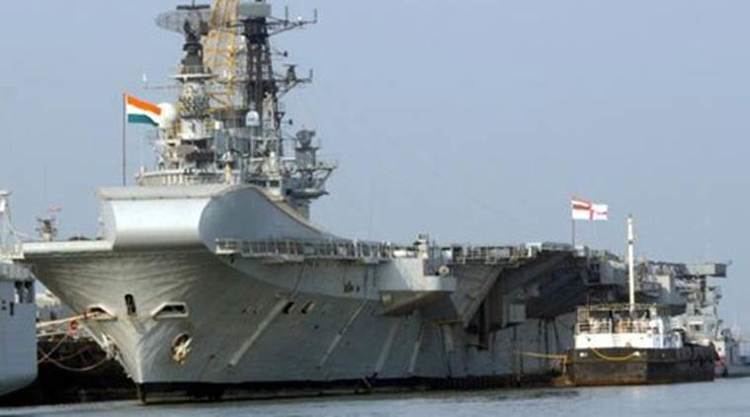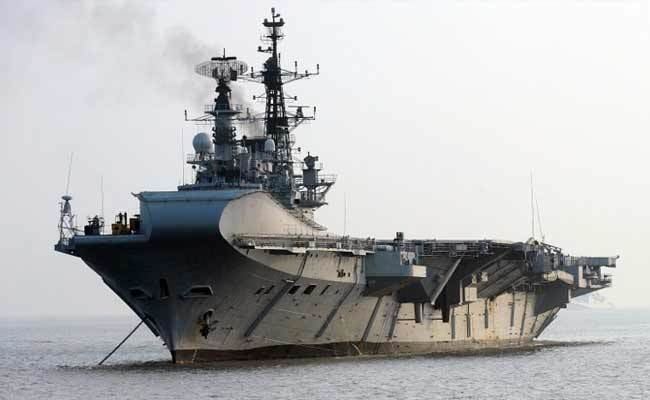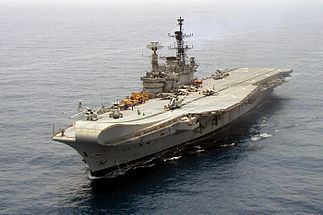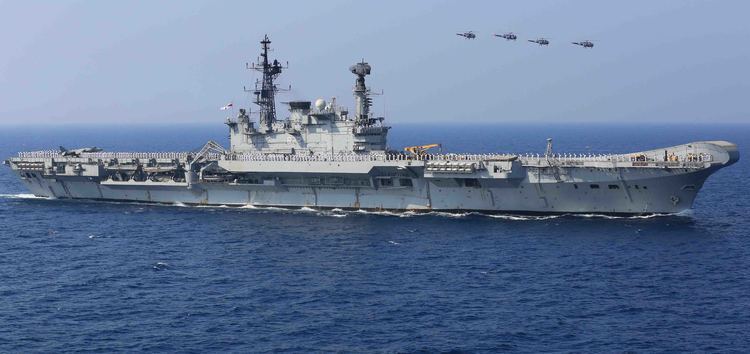Name INS Viraat Recommissioned 12 May 1987 Out of service 23 July 2016 Construction started 21 June 1944 Draft 8.8 m | Acquired May 1987 Decommissioned 6 March 2017 Length 226 m Launched 16 February 1953 Beam 49 m | |
 | ||
Refit April 1986, July 1999, Mid-2003-November 2004, August 2008-November 2009, November 2012-July 2013 Builder Vickers Shipbuilding and Engineering | ||
Ins viraat indian aircraft carrier video on request
INS Viraat (Sanskrit: Virāṭa meaning Giant) was a Centaur-class aircraft carrier of the Indian Navy. INS Viraat was the flagship of the Indian Navy before INS Vikramaditya was commissioned in 2013. The last British-built ship serving with the Indian Navy, she was the oldest aircraft carrier in service in the world. The ship was completed and commissioned in 1959 as the Royal Navy's HMS Hermes, and decommissioned in 1984. It was sold to India in 1987. INS Viraat was commissioned into the Indian Navy on 12 May 1987, and served for almost 30 years.
Contents
- Ins viraat indian aircraft carrier video on request
- Ins viraat r22 world s longest serving aircraft carrier erstwhile hmw hermes
- Design
- Aircraft
- Royal Navy
- Indian Navy
- Decommissioning
- References

In February 2015, the Navy stated that Viraat would be decommissioned the following year. On 23 July 2016, Viraat sailed for the last time under her own power from Mumbai to Kochi, where she was dry-docked and prepared for decommissioning. She was towed out of Kochi on 23 October, returning to Mumbai on 28 October, where she was laid up. Viraat was formally decommissioned on 6 March 2017. Her ultimate fate is currently undetermined.

Ins viraat r22 world s longest serving aircraft carrier erstwhile hmw hermes
Design

INS Viraat had a 14° ski jump to operate the Sea Harrier along with a reinforced flight deck, and 1.2 inches (3 cm) of armour over the magazines and machinery spaces. The magazine capacity included at least 80 lightweight torpedoes. The vessel retained commando transport capability for up to 750 troops and carried four LCVP landing craft in the aft section. In a wartime scenario, the ship could carry up to 26 combat aircraft and was suited for supporting amphibious operations and conducting ASW operations.
Aircraft

The aircraft on board INS Viraat were operated by four squadrons of the Naval air arm of the Indian Navy:

Primary strike aircraft have been the Sea Harriers operating several modern missiles such as the British anti-ship Sea Eagle missile, and the French Matra Magic missile for air-to-air combat. Other ordnance has included 68 mm rockets, runway-denial bombs, cluster bombs, and podded 30 mm cannons. In 2006, the Indian Navy started the 'Limited Upgrade Sea Harrier (LUSH)' program by upgrading up to 15 Sea Harriers in collaboration with Israel by installing the Elta EL/M-2032 radar and the Rafael 'Derby' medium-range air-to-air BVR missile.
The fleet also consisted of Kamov Ka-31 Helix-B airborne early warning aircraft and Kamov Ka-28 Helix-A helicopters.
All Sea Harrier operations from the deck of INS Viraat ceased on 6 May 2016 following the retirement of Harrier fleet.
Royal Navy
INS Viraat was originally commissioned by the British Royal Navy as HMS Hermes on 18 November 1959, 15 years after she was laid down in June 1944. She served as the flagship of the Royal Navy's task force during the Falkland Islands campaign in 1982 and was decommissioned from active duty in 1985. In April 1986, Hermes was towed from Portsmouth Dockyard to Devonport Dockyard to be refitted, re-activated and sold to India.
Indian Navy
After evaluating vessels from several countries including the planned Italian Giuseppe Garibaldi-class carriers, the Indian Navy purchased the vessel in April 1986 and gave her an extensive refit at Devonport Dockyard in Plymouth, England, to allow for continued operability into the next decade. New fire control equipment, navigation radars, improved NBC protection, and deck landing aids were installed in this refit. Boilers were converted to operate on distillate fuel.
In September 1993, the engine room of the ship was flooded, putting the vessel out of service for several months. The vessel was back in service in 1995 and was fitted with a new search radar. Between July 1999 and April 2001, the ship completed another life-extension refit expected to extend her serviceability until 2010. This refit upgraded propulsion systems, added a package of sensors to sound emergency alerts and introduced modern communication systems. In addition, a long-range surveillance radar, weapon systems, and a new hangar with fire curtains were installed. The lift system was revamped to reduce reaction time in the event of an attack and a new flood alarm system was installed. The vessel also took part in the International Fleet Review in Mumbai in February 2001. The vessel was towed back to dry dock for another refit in mid-2003 and returned to service in November 2004, during which the vessel was fitted with the Barak SAM.
The ship underwent a fourth refit in Indian service from January to August 2009 at Cochin Shipyard, Kochi. The refit was expected to ensure her continued service in the Indian Navy until 2015 and the ship went through exercises in the Arabian Sea for a month and a half before being deployed to the Gulf of Aden. Navy officers later reported that the carrier might be kept in service until 2020, as two Indigenous Aircraft Carriers (IACs) seemed likely to be fully operational by then. On 12 July 2011, the ship arrived at Cochin shipyard for a short refit scheduled to be completed in two months and it was repainted. Indian Navy indicated that the ship could remain in service until 2020, provided that there are still Sea Harriers available for ship-borne operations.
On 2 November 2012, the ship arrived in Kochi for the first part of a major two-phase refit. In the first phase, the hull was cleaned, probed for corrosion, worn hull plates were reinforced and received a fresh coat of corrosion-resistant paint. The carrier sailed to Mumbai for further upgrades to her machinery before rejoining the fleet in the summer of 2013. The refit would enable her to serve through 2016 and was the final major refit before her decommissioning. In August–September 2015, the ship underwent a short refit to reinforce her hull and inspection before her participation in the International Fleet Review in February 2016.
Decommissioning
In 2004, India bought the aircraft carrier Admiral Gorshkov from Russia for US$ 2.35 billion including its complement of aircraft. It entered service in 2013 as INS Vikramaditya. INS Viraat was expected to be replaced by 2015–16 by a new indigenous Vikrant-class aircraft carrier. After upgrades, her service life was extended until 2020. By 2013, Viraat 's age and cost of maintenance prompted the navy to begin the process to obtain Defence Ministry clearance for her decommissioning; in December 2014, a review board was established to determine the ship's continued service life.
In February 2015, the navy announced plans to decommission the ship in 2016 and began the process to obtain Defence Ministry clearance for the carrier's decommissioning. In July 2015, it was announced that the ship would be transferred to the Government of Andhra Pradesh for conversion into a museum ship at a cost of ₹20 crore (US$3 million) with Chandrababu Naidu, the chief minister of Andhra Pradesh confirming the same on 8 February 2016. By April 2016, however, the plans had apparently fallen through.
On 23 July 2016, Viraat sailed from Mumbai to Kochi for the last time under her own steam; by then, she had spent a total of 2,250 days at sea and had steamed a total of 1,094,215 kilometers. At Kochi, she underwent a month-long refit in preparation for decommissioning; during the refit, her boilers, engines, propellers and rudders were removed. The refit was completed on 4 September, and the carrier was towed back to Mumbai on 23 October for her formal decommissioning ceremony. Viraat arrived in Mumbai on 28 October and was laid up; her decommissioning is scheduled for 6 March 2017. After Viraat's decommissioning, her weapons systems and operational equipment will be removed by mid-2017. Her subsequent fate remains undetermined.
